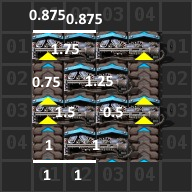While the purpose of a balancer is to ensure perfect distribution of supply/demand across available belts, the purpose of a FR is to allow for perfect flow of items across available belts. That is to say; the throughput will never be lower than the lesser of supply or demand regardless of input/output combination. Routers have the added benefit over Balancers of allowing for much more compact designs for reasons which will be addressed below.
There are many situations where a player wants a number of belts to have the UTU property so that as long as material is avaliable, machines will run. Most prominently does this apply to the Main Bus systems, but it can also apply to any smelter array, mining outpost, or large scale lategame factory. Currently players use Standard Balancers, possibly ones that are UTU if applicable. However its usually the case that even distribution has little to no effect on the factory. It is in these scenarios where using a Router would be preferred and result in improved factory throughput.

The Flow Router achieves UTU by ensuring every Input Splitter has a minimum of 2 distinct paths to every Output Splitter. Distinct meaning they never share a belt tile or cross in a manner such that the flow of one path interferes with the flow of the other. As all Splitters have 2 inputs and 2 outputs they require 2 paths.
Creating any Router f(N) can be accomplished by first establishing the factors of N; where N is the width of the Router and is not a prime number
U, V such that U * V = N where [U,V] =/= [1,N]
For example
12 = 3 * 4 , 2 * 6
Where multiple factor pairs are available, the combination with the smallest total number of Splitters is advised to lower the UPS cost of the Router.
3 rows, each comprising of a group of routers f(x) in parallel, are connected in series. The 3 rows are:
R1: U * f(V)
R2: V * f(U)
R3: U * f(V)
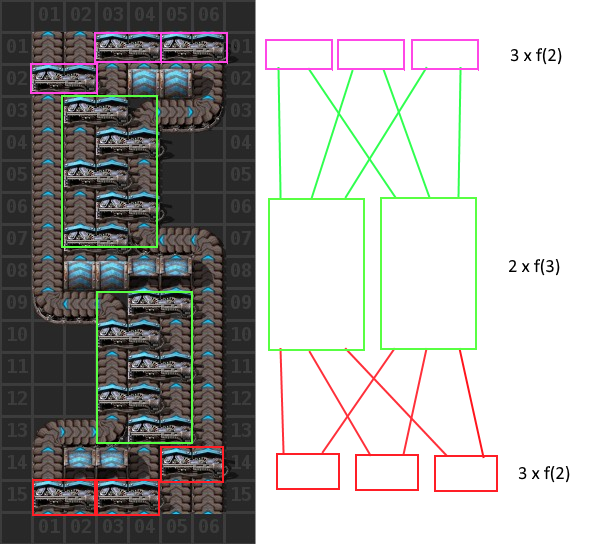
Where U * f(V) means f(V) routers U number of times.
R1 to R2 and R2 to R3 topologically are the same graphs, except one is backwards. This matches the common wisdom of pasting a balancer twice in order to make it UTU.
Thus the number of splitters in f(N): 2*U*f(V) + V*f(U)
Minimising this number will give the Router with the smallest number of splitters and thus the lowest impact on UPS, though it may not have the smallest possible footprint. It is likely that the Router with the smallest footprint is one where U and V are closest.
Using this formula we can choose the correct combination of U and V out of all possible factor pairs of N.
Note that as in the example of N=12: U=3, V=4 does not result in the same solution as U=4, V=3. It is important to check both orientations of each factor pair.
When connecting the 3 rows, each output end of each indiviual f(x) in row R must connect to every input of each f(!x) in row R+1 exactly once.
This requires that for any Flow Router N to be optimal all Flow Routers corresponding to factors of N be known.
This method can be verified by example of the standard 4x4 UTU Balancer we all know and love. Notice that its factors are 2,2. f(2) being a single splitter.
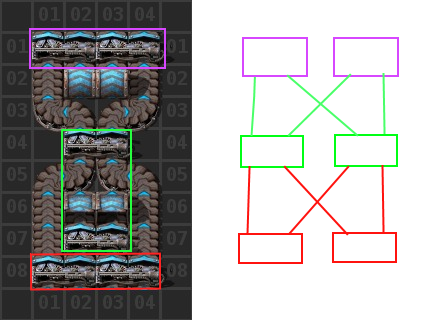
Notice that the balancer totals at 6 splitters. 6 = 2*(2*1)+(2*1)
Notice also that the balancer is constructed as 3 groups in series of 2 splitters in parallel (topologically).
Notice finally that this Balancer is in fact UTU and thus reaches the same conclusion as the outlined construction method.
Using this method of constructing a large balancer/router out of smaller ones means that whenever the design of the smaller build is improved, all larger constructs that are based on the lower order design can be improved in the same manner.
To this end, since a flow router is not necessarily a balancer, Splitter Priority can be highly utilised to shrink designs of routers without regard for the effect priority has on preferencial output delegation. As an example; Using this technique, the 3 wide router can be reduced from 5 splitters to 3, while the footprint of the 4 wide Balancer can be reduced from 4x8 tiles to 4x4 tiles. This has a cascading effect on all Routers where U or V are equal to 3 or 4.
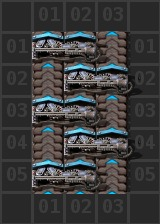
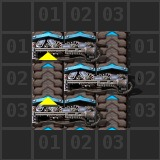 -------
-------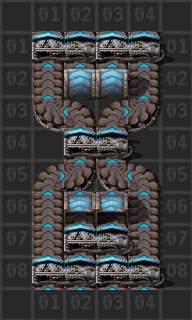
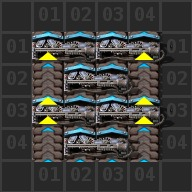
Updated Book to include 7,9,18 Router. Added L turns, removed U turns since they're really not useful.
FactorioBin link
0eNrtfV2Pnsdx5V8Z8CoBpOzT3926W+9eLJBgL7L2VRwYlDiSB6FmiCFlUwj83/cdDueD4ltPnzqnH1pxDCyQNTVvVXd1P93VVadO/eeLb1//dPnm9ur63R++vbn5jxff/OfTv7x98c2//afjD+7+29vrl2++fnfz9Q+3V6/u/vf7F9+E+tWLn198k8pfvnpx9d3N9f2v3l79cP3y9d2fvPv5zeWLb15cvbv88cVXL65f/nj3vy7fv7m9fPv267dvXl+9e3d5++Lux9evLu/k/eUr5edR+3nSfp7/8u9fvbi8fnf17ury3hAf/sfPf7j+6cdvT3/5TbClfPXizc3b0w9vrh8s+8Gw2z+Vv9wN6heC4meC3t2+vH775ub23dffXr5+97m4k6APAsN5gckxsrQ3svyZoJ9Oxrn94fbm9H+NscVnY/vqweo3P71789O7F2dUFPfkw/7kq2PyZW/yjZh89k2+uyef9ic/HJNve5MPGzH76pt9CO7pl/3ph+iY/9idfyLm353zZz6v5tRRPKfU7jEVqv9TnRxUoblFjonE7pnv7uEXBrE8wXn8ReY7C8GpxHVV7R6K0X9Zhby/ZDH5RU6OwZj9IidHSyz0LR0NiZWWmAyJjb5MrTF2WqI1xiFcq/HDfn91dXv53f1/rcDuT5ugMf1SY3zUeHVtKQz0tW4sQ4q0xM8ncE6+/xOs5pKck5/pm96ySBHu551F3dlG/s+1uWzUaPnGp5Y6f2FbZh+8SGOUeaN9AGOQOdASrTESt170LH5OvAJrzFnxLHZOWvPcy8RbLniOqVx558PaK40XaRm+8/6MNcrBizRGWTbeRTJGWQIv0holHxvJhsRESyyGxEz7SNYY+aCINcYq+ECF8IEKEz1Jz8yChI748ElBjpsyhBhIJoxWN9pNysiEaiAmVD4x2XRRqv+L7dainLspa6LdJONrq5mWaHxttfBekjVIIfiC2ZX5YMd8s+/slE67adiMpPhNYabUNt4DMha+BV6ksT2bEMOxRpl4kdYoM+/zWKMsvEhrlJX3eaxRNl6kNcpOOz3VkDhoie28xL4JyabGBIZ6oN0swyo90hItq/g/rPxsjFOXoGdavjXiQntlllUrLdEaYxM8O26vdcH1qoQv2YegsBGv/7HRjl9DrvMRhGxZfe682lOItCdobLSReLfN+BpG5kVaoyy0J4YtXeV9GMsKjRdpWaHzPow1ysGLhCwbNip/mOYHy05KeQuKTuZsCVvkfaJqIRwSL7NZMjPtFnVLJJ94HJZI//cYn41y6lSErQm+3IDO6rDxqUlwEoNWYBk+bLS3ZW2PEITIHmjqwKcfzWEnIT6IDjvTWc0OHb6hCG4kOolKxwTBSTTBUUQn0YVsLapj0M4bZqi40Qqs8yAG3pezviwGoTO7MAiIzpgNM9MizVEWPokKboGqhBTBjRwF19a0dleSwejABW/XGnjaeJnWPiHwOSG59gmB1wlpNmrBXTWtK+DkzHHy/mqwQJ2purH2wQT2Noes+DSur+53/h/e3F7d3J4knn7/+vL7819C6m4Evj3eIXhKAYYiKyA5XEtwg/NNu2QP1rvuruPt1Q9/NAac3IB6e8CZDpCZHwYBuWlTmdUNorfnrGQV8W1F3W6bW83wY+lNy5zB3+wIi/tLVoIf9W6PLDLWdJ8FJSlRJFxN9mPfbdMUAVduLh6PAw/Jktl4mdGSyQdc7HEOOhIVEuSKEZiaMLNEDfyoTZme6yzvW5XAyKTn4wOsyqcNP9dwNvpGYGiKuTPOa6h0eMi2fONHbe6Mzo/TlDl4X8SS2fj4iGlPAv3SpuMUAiTg59H4eAmqIRO+yP13cX9ZfvaO8bxvmhBpsddFyBLaQhvhGVl2un8nuB4QTUgqgidlE8DhoIougMXNpSHgN4+fYbFkCrX02ZKZeA+iYObNvD9hWqL4QxB51fnQq9+ZMSfS/DGDvO4D7p2/0c0pDf5Gh6CvYQh3sTXqIdzF1rc1lLvYFJqIu7Hs7f2zWjLxgDeHXIhrquzu8rNqqnBVmGMX3poWjmLwgNVg4T0GhQd/PlKonl+BseJaeOiqZZ9IYGzic5nTey5uwrvUHLXwEjVlFiEljq9hVShWYC3Ci7Qid03chPepuQLC+xTbi4GHq1qnVgzCDWnK5DGppnWDgEq1hfIJfXTJihTmb1AWO4aqpCxQJU3ilqko74uU9sfVCIl/8JAhwDdhenfEIGU6wLWOUUp0oFoEeAC6BgqrjnW+Cbw6oVsyq//tO3wp/ihw7YSOmbvz/hioYfif1sOZQo8U/U76dCLT3Z8UFCysJPKuFAQ5jgIPD6pBACFYnxuB+HmUOSyZPNuOPc4muD2mUL6K2ZYpsOx8/EBnn77AumOuGcG7E6Jv+zJEPM5j1wX5eYjrmCbJgmdkbY8slDHbQgVuHXv6TRjpwHZEF5wS0xhDEGoZw4X4ufdKYlgUkY+FhyxEiwqyRLf7YE7IH5mPJbmTDPZUBII6UyZ/LdoyKy/TJLZs/nD5hwGu2ZgKSZ05pcFzygXo2KmbP2BvGo3Y/DX4bynTXFUgBPncXmdv1SqQvNrjFh6k5idWBYyfPVIe4xctItXK511ixDZ5FzImMWGvKoqmJzqVNB4FCNqqCResRb7b+LpLWyZPKGLLzP6b2KQwVnIv8HZQUi+wEj7zYluaz7VECFgWG595MUfd+VyLuU86n2uxZfK5FtC6Xci8gAdR5/Mw9gK64Anb888ER1REgucnTM/QLlRT2kKlvAp6gHSJwA7VMoQKS9NAQyixBD+l4Xl9hry/J21Hewh5Fds8iuNqEusLHQqKJdNfeBmzJUvoTmCOj8+R2DKHP05jzDltSvIjgpSriUAD5YkV0kYEd0wrJMWng62QFacO1lLcFaG2XapAaYaPuAnkG7iW7q4ate0ihG+s/UzgfcI2FRqI0Jk16xAlpwJdKIp5J0S3mkwEyEzTCBkPe/GUbgKm0OYvN7WnLeQ27BHyzK2xWe1pNl5mtWTyEFd7nDw/qz3OxLsgpkwe1Bob1PAnFsUxqVQfJqLhVZ5aSmGvOmMroLtT5CtCIgS0SpGvDwE1JL4+xPy4KAxOB5ZiZ0slIWIDWoov5bQtJVC42kJ5Elfz60pC1wFbqBKRwU43pvNVnBp4SP5ZJXhPEwHTCdG3wbMSqrFslZWMoilUySFau1FB6NhClRyiOX2h1YA9UiGJOCyZfPFW7JZMnozVHGdRSrXiAB9CRfBjLWsUvlQrQkC7VPhSrTgwDVlpBDoYz61ITm+nVCqNt2JH9xjfO9L+OjqftIMwqKnwjK3ml1GFbpLYqKvA2YqqiEIJ0t4+3etuqmQmzdXIgqtnbcxapADW4MwjkJPY5hHgsbZ5BMYRW6jAMWJOvymZR1Oo0ITSnH4T2g/YI+U7UaZgyeT7D6TNksl3o7THWQXXKwUq/NT4/KNtG74FpW2bQYfJTJkEAifN5t75rGPaIBexRyG4t7dLbH+tJyGJSG7MnpVpboxb2nneWHuP8dj0BIGIE9W2q31qqLlp+IIudBpKE3XL+kPIb5qf+BCaT9ojFWq47JFKbLLcWTGE0BG4VUaRprVRvu4QEqP2AgldLe2tJCRI7ZHyCdJktYTf+ARpsnrCCxxA9jij4pdhiMO88YR6CcLA5o0n1EM1KKEk2FBK8AhW0njX0NyanXcNTZlKQ0vUGGFT3D9USaATyAnCxmaCNKg6NfBt2M3DJ2QhgQwbX/B8QdNU3oE0TSNQF9hCBU/X+kqD4ttaQuOmZF7RncGxAXkvv6h4v6aBEp8mBnd1FNqxmzuQ6diVp0IFkkvUGE0Yt7mIijNrGkNgMjBHmjZ3VUDKlqzgRtvbsvyYdVuWv/OPLSu7sdG2rOKHHNvCqh+kawsjoK/3wv79qxdX7y5/PP3w29c/Xb65vbq+25avX5725+nfQn0f6sW/nh6sl7cX//C73/7u4urH37x8/fL6u8vbfzz93Z8ub9/eO+o95DZiK6GEVLcPNFWvLu+eUnfDfRJ9GsHb65dvvn538/UPt1evflEk/+F3391cv33xzb+d/vDqh+uXr+/+5OFkvxuoPdEnpeFuWh9sdHV5L+uXhLTuj2hzcpS5v6zNSe6V3N+bcwrZ/RF6p1Dcn6ZzCtX/vXrn0PxFWovoOwSaZqNjur/2ah3X++bvDGi1N/YXT63i3o88H7LVgZBnbbbawvlrqNatcvH3DbS66PhLnpZ1YOEp96ymBDzhnkW4ThRHrWPI2fwl6xZ7i5AFsUTyfUqs8loBTWCxoNFBVGuMReCTySAZcXUf4iYVCX2SZowMgj5XzRJrJV6MFnry4WKrIo0OVmasnIYOt2LyJcgAaHUJIoCiSOk7xSpg5ElcLYkeV7c/mz18syaplyx4SFGlJMOnIxMXoBkp5i9AK1qghEGtAAR9AxrVEZlH0xnVt9nflas6X8yVvrWtMTfhVqlYVLwLKgoBgCLKSZKp7lxUYaPvNGMvFv6WNNaVKCLpkzEmAZ8FNpsoPIG5ZQc+I2hJFMomoaI9F2Xrw73RALnS5VcYtBFRBPJ4EUC2YhpAh/31rXznSgMMXvn3oFEuWJP7pulOwraahedcZ6CyBDdrnJhJgdiA5Vm1uekxrdF24anRCYxj5ZkIjCk0ngsSqlwUOkZD/QEaf2s2SD4PrMHkC9wDxuHVeOYBbEmF6xSzicBIYNmk8yKtL4d5ND6mWzbsrOo8UBUq++08TXIwALtUlUg4axfzHOw8yY9RU9aVy5Opfu4KYjVszHXdq6ASrK93tYeu+xtJuV0Hto8UECumYgiNLaGyLKUPtGH5EQXkJ7hRBn+xGp/wyFI/yo3wxwZ/1Zq2r8osqGrq0YTwJ/gVCPfvmZU5p0F4uBobKmz+FkEh+uKDYRNuYKhoKWw8y16wcskb37YgQBUdQWkkHTANhQdSgBqqG1gRomVxhVnvjM3n32xQOkmbG2fwTRtNdI9wxVrmdkGG+vNN4YC+EOCgp/vKHHlSGiZH5gIJQbt6A3SHBK7hdDirZW8yfHOgkK1F4Xm9QoLOmtD9d1V2RhhD4Gm/ApS8DwR1bXxuqLMyg/IiTczRGQXYn7WHor/Bnm2SzB/tGdqPUWkcdGazIF8uUWpSp5tHuncTdZxGnuvL3j08u5cp01V40p9bxNHyI1BEtmEDtpL9/RIgpeE76Agi2+A8SymU0vZpE/q5pYofpV2t/cSDJUKxZAqN4U2ZCj4CNuxQAoSgEoLQNj+3znwTEmClNLN/jv4go7XnstDj3Rwf374WtWrxn7zV6+3lKoQBQwF3oEIiBCvpBPrc3DFKO3gIrhSK0A7e2pQlSK8n8EApSkd4c+g8lNDqKR5KdldphbaqXKQQl6Y5kep/+LWF5Ts8LN+eEg/Ft2UOdw3YuvV2taeu+xNxtZpuy9e78oALe0p8LsiW6S/yXrjeRINOeyZEyerSFRfgGPakuv/4HV4HpvrLV00ltn3a5j9Z3FNpxFdPTCX6Pxr/VBKxnydzmVAWxPchSpQFEaIs+DjWvoyy4Cvl51H7efITJojF5pFiYBB5EHYLx/mSS2NkhXaWDIGV9pQMgX5wrGE7Pnm4oVwE6KN6s5KRy0rPw/JqbQWCg2a6kjuIsMEMAmK1cxC6J8P0AHgWKFH5iCZojOAa8h2XE8wTADezMc51vkY5whQAjjYuYOV6XF1ZHXnQTIIq2JWqZNQqhe+FaFiFT9qtYwoolp3jGqaA/omVZ/IHWVXtcPWVjpMwbwCOO0kM4beAnkkkkwDcvAhqqKD0nfylgryGQiC6KQRmb12cOsBDtwHQ+rsd2bIo/JPGOgaNqFIJ1N2p+cNBRD6vL+cemNBSZAUCB3ZUJ3J8w7N/s1ZbOd9E/MsRk9+E9DVYfO5K6+1TS/BNfozysKJQl6PF90EqB53Xn/NUPQ2mJFhaTknQEUyKAEqRSs3mI65y1fbMUSpN6CIBFlULKTvMTAqXFlajUnmSEKjWsobDi81qlIqq5lNI9OVvfF5VaTKAbX+qQWVzcgpUrZZEpSmYiPL7wsFLqzuW14q0jSsldVH1CkkM6I3Xogb8xygJHHB2phKo8bcqVr3Qiob6P4KzIM+WgX/AmiKJ73QVhW0TCrOM6fRtORy/B/+ZsI7EtgvYFyji1AUgDKYgK8VhWE8VitlAK0DrAiXJ54bLGK+Br1RvrkEgbzeAk30sr2Rj+lpORjn8LUdC8ca7R9Qq1zAGA/xZFTJWN5/9TqBl5rK8JG0ohCKoBZof+FSckKShMI2g8xDu17yCn2Ds13zutGHgI74moptqbNl8FmdICqYo+i2vBP/XRbwEO9VuWSYmQMDvIGMBfPtYtRcbD3cIDackoCvYAg91MMcX+Mbutszof2lUnHAAPtnM8Qn1yabMsq5qLPDN1e3xNd75N2V2rk5sAqgd74cEp80InPbjcMp/VzQtglmV2o+JcN20Cq6bFS8STE9QvdfE9mF1b5kc3cMctcUgSR/VJ24JJHcGe92oDnNrILmThgYhLge58p3X43IgboSBuDNPIcEAXA9Ude44NwlmOpffVwNjwzgYqLjR8uOy3lvZBX3kE5jrQLd1eSOuCXTyVwGqnbRKiW15izQOobeq0Vb04b2Snwsyr8ITKsABdHqRAnauyauktLrlR8rLW10pzfIauAh1ddsJgf2mQhDmvrrJU+JbAVnYPp5SDrIBgYgtno4pmeeSq8tac7X9fZazEEEHv47MNway7FCltlDzleO/Pqj5Re6rG99kf8X88IUhKFxs8uEdeUrlTsJiZ3fl8LZB52OqUA+Pklf12bFXoUidX9b08aouozR/Ijos8vEKCdFb08Jr1tOjbhwWcY17WPkL1pxQ1Clhp7jTtBz6VwUgHvT+ruVgPKQClI0LgLL7vLhUQ6/o3BbC5xmXNfHKM5FBp72dwkr58hJz2CKADgO/OsAhoCX4uzJAscsmMCNHsmfXFFGQF6Bg074ogvQtw2DWKQ4pzzOp/X2XMqn175nUeSbVcbWDLAjHMRWJSdm8ir7nwIyp40rFlkOiaP97ynQnZeq46UC+miilPAHS8+UJ0LyavSYUKZE4t4GfETatYr5sUn5wTda1eDKOwe8ipGUv27ichSUGKZXIJGhnF0xelpidkJPE7N73XqQ4kaktk0H7GVXcxQ+xrcpdmS+YqCWCGE6ktYmsbXnqLRxPgEFQIMVJ+i1JySwsFYuHmlE7lFXpJ5ttqkrZpzlfUVudk0v92OxWGlJ2a02mdpbPClL/bCwbi79nMBYHIj2bXGlD/yPRMkY5NtNGdSDxUWbkdmymjcjRZpf8ISXFsAytmrgLq3s9F7Gn7TwXKERmrLwcj821KDKKH5xriiLaiGyrkp9N64G8ho9o1meW6SCyrUuCbsvbvFeBtTrAeVUXDcz0RqhJy4BiSdVp6U1yvhvVvOqaTOo0vdzWJ2e7UtzzZTKqc/aYTUtUzrNnBK2Jm/K3xfVZ4qQUK4G50azlRhenW60ssZhg/XtK9VeTUm1Qr5ePTZvCopxqXF8fuqFdVuALdFUOc9KCxB/GdZbCluPzhQLfmN6XZde6REW4E7w6vkAa8a9ZJzqebd8514bQSRqSz1NyblB+LH/xtilleVVsXV6526Q089zqfXXzEVeeMz8bKU4wsK1uRRPD8lY08dhsckxUNvm/QpXpfO51XbuMvKYCdbja53SBihhtnzMEHVSTlE04vtHaUZ5qAWvlEaXS43mblCQVS8/lKwQnhc6AIrgMTwwr8fwNZVl16qw/TV9VKm1/UWM1BCRvQhQFbVcSBMI9VIfWyGWeDUzCwwJb3JzXte4Bu7rg5z84Ba2IfHqaZR1M5HwQ5C5orATfeR7HgpnKJtW4zwtUw2pYkKvktT4bqVTyOnOd27JEa3aZV2koURl+a6pJTJt/c56WMZ7OQmsSst3V+WfQ8uuCotf4DHLiSAuGw5v/1ChhqqbXgVDlOiD5ivM82AYxNN5qUc1rdMnnIUxjQcOY+mykjnRkPb6jk1AX2xeWxTbXB9uiO7Q93Kng5X2ciCxtn5iaDwNbgJdWNVDXHCjQOBCVmrKdTNvfT9gSpbR02eap2/a+SanbsDnKYfOvMXUbfKnbWYxnWdlpXJeyrXuCyuqC2Lq6HlB5/sb1xaYUFzTPsbaiCDUx2aUQjk/ah4OzQyEdz+0c8rEMrT4W/YfMxWdPXjwuEKpUMX0EbXBbXrJaJ5/XWE6+uq1OiUflLZuZuCBRi5qW16KmZbWo+ddYi7qWj5qvDsc5hPGUQCYCY3Ecm+NIm0SAPc9FhlX5YDtBFqVSXSxBuz6Bmo+NyVMlql6O6rqO6XZRjWqZZID7sdy5RLI27484b8vZeHnKhnIQf3A7jD+4kAWqa3l5y7qYePyvloLtTEK000c6lLzJfAUPlhzapAj8mhRrmiTIopSFwDKq+JMZY0WQeIQbyyM8C4R2b+q5Cl5kpxK6bXmNdV/NH1HG8ZzudTs4exgOjvhXFxXgY6nrZzvGkTNOwuE/mHc2wTocJ/nFsp6iWiAW3pYRC+P5VDVDu7wYHcuf4ifAIF7XTSOKmNfZxuVF9E0BJX5ckgNKYIOv/rho1BTzxGhdXv/emlJZHjHD82U4FkNCU3pVgcPum8anMV3OTtSrB+/p09fTg/e0vAS+8/kWa4v04q+LtkZXl1N89MbRZZwT1Zcx93celW+JHNtyloDBh3ruRR4MnwgIfKL+1Svf0ctvAYwirK1837wwii/QCRm+GvSOyLtE4XxwOaCV7suz7WNVVX7wg411AMVfryFyXNYQeVaondc1BZbhEGlxe+RJs16RjJspUl9eW+oqW49cHn1b3is3LIdr8MFhnH6bzKnaufJ8fMpTAEGU5SAIKMMvgiCOKWPPvoVdSMZd15JxV5iMe/bS8NavuToop13i5nRwGj/TO7zBzZFV1nCeQAlvheyNm0+RL31dv9e4Bs0wY7PeDs6E+787dyFR5u/GAeMblnN859UZ6VwkImsMxoD0ucUAC9Mnt/VE7stKbPJY3le0CJ0YgfqY+r5qAZ6IBHg+ugLLusUtj+9MSj647myOp3Qi6zN0puxMBVtcWAiqgdwijmv641kWUpqEE7p7a8VFK+9/By/r6cXW9qzYEiFQGP9FyuPybmbJvYG84YywrvLANkzRgPz7t1x5X7RbLiO33EcSrL/eLYfcGUv4ezcvf+/i6zKvrjYsh9+ClTpt/7vdQCol6Ze7WPYPnPw+awdO/Zs4cLbVB872KyQMD0v98UJl7f46ZeoYifoKv6mv7pg73AvsbdBCnEWTBhwHHzlQl4L0WH39qztyKE8iruatSGtv0yXOz7bO+YlrmTE+Idfe39/pfdL2dz+n4Otvb27+45mWew1vLz7TcXH6o5ffvbv60+UfPgrcEK2f0sf84YO2b579y/2un311d+mxu5t+Y767X6zB86/vq18bzCpaPAtxTd+R5JHv+pQfn+lACoNJGxVz5EDBk99Q1WMo/3cfuke+/8kTmke+37uIm6ejBpHcHp7xBwKdHV0tOwKvIMBQr51bx/q6XLE3IgmexcYmUwXJpYCq+E/zk2MHLeWKW1RzmTyhQILDvbg+F+J7r651GvwMIAVMYxTXicv0SXE1AXIx7cTH05zqlwLcrnYrHQqURncpiWsAaWNCJVR5z8wS2XiREWbigf07zLCDV2CYgcCZPXqOUEsZpjOKi1GO4dqp+wtJoM8eRUIsUFQ7lNDm37yrOwrsk2Jz8ly8j+50AgQ33tvFdlDn3d1EgtZ27o5HHPTcdTQjLlTLoyHcKVlwuI2vMLtu3GhazRGocqFaAr6FGahb9uywLDna1IGSq6IyMXus8W4wxAznAtY9OsDI+hP+dfMcYcVVO+U4fAtDlhfbfJV3yvOiVM8wn1KSyMbWdFsxCRgjxv9Dk43FVeQ/3ZwB1VvF2wPKqbCv46yMa1qvjP3iJIIWaOzvUq7TirMYiei1EiYN7Ti2n08LhhiCH0BJdSopittfmMO0VkVlplQ25iGARO2FsDd0DlYh7g0pILqxhOE5h5rghmMzIPLPwaUg8QowEwm+eF7WpyVOOFYJtqCYXHZuivvOXPpNiGJjUxq8AqhLLkMq5HLEXKRC0XF0niEScrjx1DUgEA01yFZZoh+dyy+rS0R7XV0i2ts6luCIsRMt57/sYzU38+Bd57qMtGjs74VB+MmbZ/sOyms2KYuB831kHlUB7cZBuc99PqUdcpvKR82xOTXFPwc/sSE4ztgsqAB3V7ARmyfi9ehENwSbIvjQFUO/CE40qEHwohumITPR+S7hLDbBz4ZY5cNWeQ0V09B4xx5c+6549szJHzbB88YmxSDGJu2YAwMSa75RR8afRw4pqo9abMpdGILCzddBsiuirtKkWz5vuSoRUQMKlOD2YD6/0NdxRp+fEsPYO5wrHzcFCAVrCTy2A+J7CVEApAwLe5oUN3FQn7urf9ujmz0QCwlYFHANKu/xYp8Egx8bvjl0BcRBHSQEwCxGTzOKkDYGYoFsKgJoFrNrQRKFAL9ryMzieALV9i0moc9RoLBpMUlHDQFOi3WfuSkkCgh+ZrUcFZSpMQASaHd33lfFDjQfSM1z3FNotNiU5kKBwaO5+P9DjhrrPaAhaa0XAA08cAXVwEfRUQ1V6Yq9oS2lGae+2TMBDuLchXdEgHtl+6/87moPFcomPB7O6ABMR7SmC86Ps0QFMBK42iYCuhaKc7WyoMIqnStKQadFF1+E2Dy6yFJ0fm/v7i1yZ95dISDzGULhqLUOBFItbrMdQ3SteypBxRa3RuV9xR1MNQl1qeC0sqBigx5xVYjDo7MQ8C+oCgkBQ37cDIbNeYJXIRgPmo7AsUWnW9eEgk7QUAyWrTtnkaiqUeQsb3lZF7Wd/UpA2x5BBCFhNqoKLjkwlSShNcFBNHuNdAWo/HEi86ELRaBWU65AINtCMvsrnq9hD5LDDFqnC8F3dCKKE24ugOJ2g+MWou6oCgltHqhyodApvHlIyHwUohWo5Cx0xSWPkIohoM7BhR9B8qWpM5yA0MXonJbirluf+hAA6Oi4i+A9gyoqlQzJCuZraB47d7wMxWPHPKCheOwYc8SmeOygikAlXLICCYub4sOD80qCioSpyNQzISGieZ7yULDBSwF4ppozEiC6R6NlbFJS8D1Tk+KB8MHswidharjFCUGJ91NVjjEIZae28ZL0MM1YIzmChO3phW11NgzKs920RxUeieZIXd77J6bFPYcYXDH1PLHDEN6YllCCIe1JqNkyUyBfskcapUceVUwWNQAceapwCLgAsckV4U2G3csKBg68JWNj6j7uegWwiKiooeK4m1mBxZnfpg8JF23bOdr8unqAxuDZ0AQNW3Q6mhoYjjx4NDgc50EpcLjPNeazKiqDVMN2QuOhauC5kzqDVcNGPxSwGnnRED1IHz9OqBIlEni4Rw1G/UzMUclANbCBttKI9IxxEJVKnQs8L+Fdbi4I3z0wVEtmE0rAP9p/bgzP91yf29nxBshDiVOAMyG6n7bZEhTPrd13rWN6BhScrXuNk5TIAPhhlSyFPFAtRdJCnUsUTdsAVO7cTEWgSbY3dBeiE6ZQV4ekSB4iVeBLNs/tGogYSPV2rIwc4C2d/ch3tkwV2JPN1a1Kfty0u6eR0F2gijlZOQa2rn22tQkdTiACgFi7FJEBr4yqpMexiTSKSSI0RHTgaRhAx74pWXDQQAKZBKpCyYlbZ4ZCy2aeGQoxG2oMLc1N+RYKORs6LSXLDZFrRIWgDZwFR9EGnRYaSRt5UzBotgeN3eqDkf0N+oYly9/pOHSvV9eFh7M58MZX75kyPe/k2SIN/5t7uH1OAntWZ9trEO/h4exZGYen2HtMBpz4oIApU3vmDtCZH3wvH3MXu6BjIUzs0IhnH7GPu/AONsc+hMdktxr6KC/UYQkNQuofqj9PBJLr6YVnGiNJrSvBryS58FsPD0nvkZQ2pYrStJDSC9PcLj5I9mSEnW8MjrVNZejLnms42/aKQl7Z45778CkEt6sUN+9JmEJUJgbW2ycKe5XdWpRMTwyoFp4DIVpNuwUWM3vLKqke3OadJhywRz4EdoZI1eInArDVZ6sagzIPdAUIgrIxHbnWxfKzgs0KTUSATpp7iUFmRd99w7SzDNMVaApaFd88SpNL0+ZDqZzc2z32bZmEkkdzEaRul5Z1kkQ1Aq9sEuoazyzBWRWZL0G0zVN4D9YWKpCL2LtDyMrYQgX32GoKmwYv0+qpmiWHGCv/TQLtl2kMgugrTo3BN8eIWNvdzLfHQDUUxV2M1I2fBbfXXAu+iQZqqc6PGtTA1w6BGorg7oIaguAVWYtLNJMMYXYiMDRc02OGId6anjMcTCmfPXX3ektXPuZ45iQ4q6Ip4JW948a+TRicUpmu8xCEWuvMwJLabKQMB1efCo3CSM3pJ2GkptDMO0HFkll4mdmSWQWEdGQKFBIDL7IVntXQeQ2moYQwb4YOqbYpUctMuUQExig5Z6VggyPYGzURKKOwmRM5u6kIlFGYftIKQ5a5VQmUUYjTkTalJVikSltSExKntnmG5AwU7DHZhUyquQhdoKYFv9cu4Xz3jqEdWynBI9NWAujX3DsKDZY9UiGLagttwkjN6XdhpKZQF/b+XpaB2kwEYujxjG6WzKDEnsAue2kIgSIIfJiGEDYCNQhhI1AD3+DJXl8hLASOWggSVUyDkBc17SKEhSC75E0IC1VMg5QTZcDQeYtSMrNROhOflAWXKvMawKUqgn9t3Ad5U1zhZgltgtMOmltxfEF7C/hB0zRByYtipgmKD2ztE4YCKk2FCrVsnxujnlWhOLnmIhYpZUyVEmSGH6pMV0DJmZrmkWrXYuPMMwR33jIPQxvVp0ID74J3S2bkA3od+pAiX8kShzXq7IdUmrIK/zwwrVoVAGOH4iCZQhbl56ZFlHTewYba92WCxan4NBCQojLbgSkoWXbQ+AR5U5ttzZTcBTS2EbLyBkCNUJQwN/gtJaL2xTZLk94p6JA7/24wN4crYDQ5WBn2pDAbYQ4SnBK0bY5+5gfbDklK9qNDzoKfbVpb81fBL5xAD4U6HXpTSoxgq3fBeTQ3jOKRYk5Z4ZnNkoF4zIXnMkvBkqlwmSUQYpsJ4FB8PnLA3tldIWzbudCxYFum5/7Lz2eOl3NngrSoTDeIp/S6TYwwaF/XHF/lA7HmOKu/0NpaLKuoMVcp1gp/eVVAFySoqiPXLNBz4RPhC7LReQjVKfZWEgKu9p4XQqz2SIcg1BopBQx6dM3gzdGEwCp4wTQJXIDPJPFeJjoTomjb3DUMCqjMtmJzPRYreVs2AWZgb3i+KiVBPVNyG+7QXDKgnpnhDXo+2rMyBS8Vs0DnO9Dblkh+/yx5a8gzAewp05HzVdb2GlbeUTPHySMJ7HF2On5nj3P4nb/kpLTIY3MHCc0BjyC4eFCJSh585bS5dgSmJwTnsIXSEvAsGsUfyLJXUignse3cBI8CNELn40u2MQbhBLiP5LIJFSTW2AtDG9QmC1kIoqDHzzxbMhMvs1gylQbNCeseVbYiIBthJdXN55eKLw5QNiXJmMAig0KAcvLzdZ6eAWUbQkYWngcB0km+eRAYnTL7ygiITpl9ZQRCp07HmXmZ5jiV7CK+LyofBSyIL1EokqDmnofg0ILzGFLcETw546bEBFElLvr4bfd8th2EKFRSm19aVJxf61OLirtrjlSgBbJHWqWwILo/pNJpWAvRYtHtJXBEQdV7/CShGSN4v1K4nlDcMxFYNdGZJMHJtz43hSnI/NwSX32dqiWz8jKbJbP5Q5vm+PhCalvm8L8HmjM0VAhUT35u2LkLkPnKaXPpsuDigqMWHF4Inl8IhE+f2qXwDh046uoPJVobnKAECtOTwtXk7MFNa+5ADgPqmX7xRYDYmXuCwfHE6UiFTuD2SBMR3TRHKADobKGF8L7cZ3IRAHTg8cY0HCvT9RPQc+i4/SXQyYAUlsqXQKdhyeSZ8exxRr+fYo6Pr96wZWYlpoghM4uridhswEo5BzxgAR1n7gS+esOWOfyIO8uwFP6mOw3blEplWIm/L4ltFQUUZwrly4zNrdCKv2rCFqbg28xZN39Bgz1CBddmjlAoFjZH2jfCMbJG2IUmI7ZQiTwZ/SpdsJkwOax6lkJD6JAFHpz7/fDvX724enf540nAt69/ujz5j9d3v3n98vTj07+F/j70i3++vnuoXHx98S8Xv/3p9vriX0/e5uXtxT/87re/u7j68TcvX7+8/u7y9h9Pv/vT5e3b+9ddD7mN2EooIdXtQ3zw1eWdj3M3jSdVpzG9vX755ut3N1//cHv16sFpuT/z8offfXdz/fbFN/92+sOrH65fvr77kwe73A18ZoAn1eFONSjkceGffh7vbPVhAa4u7wf0i9VwRfAfuq8ALeVoPxIjsqfFbxCegm+gBkUMaPHQ6F0584eims/KyvHHWaP9e2g6XWmeThCi8MW60HSC5+LK5vLAmQsinZ5d84l8nz2ktaaQZt8g+bzXCH3sRA+e7pIvOJWYAiEkiSlQOtxBSyyRNlJNeqLLPbU+83OChT4f0Gow2XbXB8017Hnw/5gWw5mn54As5nkjPr5ikUbnniCXQy5/YSesU7FwYyfqaxuCxsjwUAspQuQbSR63vOFLnzwxnIevOgO+od21j7++oY8vCUEfSH4RcFSRIi72fPbdXCMcYEU0B+rPJniWltWVcHTs3yERSVP0iELMDuOkE1gtMPohgQ4QYx8SgobIaZgFojqsTkWooYzQDJS6EkhBE/KjkAKhwgQzERElHp4ZMEiC4ZlBoYB1XbkrCs9tB0LsBF89E8eti0Xk4eJAJsJT4FmYvkpLtKCHfHoUW0zFL8/U9hy0mwzNqPJueEa+aAK60Fzj59nvoL4jlXe+sfHzzjc2fp5yBBs/X7SCyZf6njANkirleSNTkTxv5irgmEui+X0DGoNSFEFplHLEhdEo8EpDZybT6sj8aM8qKLwCbAZUW7NNuSgJJpQYPCdp68qcqAZMBOwjBs9GYLhTkksBgVyMnvuB4FGJ0bOVu+K/M90kOh9rhzoPdCbW3gC5vDffoIXgY+4Vkq/49hSrfOfz5NBKD963N8DYg8+EYyPmvXmo0ITga2mu8WciOdAF4IjQkAmbkKswBz8sRiMi9J2HcAgNmjA7SRXpzDURGNKXzTOnsAlNvaEjN3DNmszbNSNmS0r7EOqcD0T3psegZsMMKXj0oIbKawA3g+DBgxu68+5uwzQMXgNmpcC86WNUPpkgOPHgpAgvvri2L4GBi9m19IH32wemQKGL6swVEyrxVBjIVBqBy4EEdwK5GzYFnhEC35q8Y/DQTXiZDGbhYxA0duqOjJEA9Z5ZORy0ESLfkdWoqQmunlPNsbEj7+hjpwtFZzPmm2xvyRudmwA/HN7rH9CtEgeTK0DWO22KZ0x99Elw97H1SAKOBluQJABpOqaBKvAy9y3if1EAuscHBKdSCuBzx0ES/H/sjCP4dGL0aRD8f2yHZ8r/L8pmyFSFG1DiFrJQ5IYVRmS+zi1gxTtZKHUD58BXu6Fz4GP36Bx4ZA6qQapy25gbM/PgHHBSBOKuPtdwVmbgZW6WTJ5cHbVEEvzTveXduZEKT6aFzkoobcNq81xNu56qzpDTuwh9gVD7dMUN5r7qMhTUTGAKZkMVGreDG6EKjF3gNVKFNu7ghmCohuwz97yhJA+fPGoq4+PHAGy6PaWSl3/GnMhOJ7z8zbnThTA/ug0H/5IAVVDgvbhzKACLQ/Qgi043rUU+EI+qIGL91XdG+PqPPchOyOB5ntuQMPPwrLchYhoa/2AB59B5DeAcBpNJyAKWIwidzMBJdSWuH5jK8dB5Ul10UonJHGSBD4SA6GXnnPhwf4BKuYLQHi1ETENTXmxUFXvofL97dGUG/2IzuiKFwff/BUc9hNg+qkLC8nCHy0jU4xa5h0eWXoHJdr92tu8QGlWgy1SFNxr24Svd2sDTi+nW5jyCOUhfljZAZEB9xbU6cVPobxKmIvL0hKiKpJT9cLdL5LrC7VybAPOO1CQuMAVwkYH6PbpVEL3N1ghgUYAkdwJZhEnmYT4BKmWJQcH5BKrCKAbpRcAUJcbAtz4OUNFRDIlA4UCbIDAA/1AVfFkMwlsA+xwJArzh3NrSWyBzW7sTNQZn1gpHlMUgPA4MSoMYJSQQdwNQ+L8QpGPBBQAMrkshCqgg8MhR+taFjKkoglsNzqL6O5GEc1XbnvMtNj8POTqfLvi64KpIXe1Cpp4JSo870HRJaP8Mmi4pzwRwFknK5VGHJ4cQ7JofR7THi8G5XFq2kLvEFVAguke6lGgj12sIaTBsXgzv3oMGqOQl5qC8TStFRBuZl2NDJpP4951RLh0JbGB8bp6zMgufUAGXtSpvwkp9DwQ+MDtnxbePDxX74AZdXQ7OgYADNntdzmoQwIHgHCJRUg59wSXxry9w7FkgcocKFWMpSiU5d6iWKj33KuXDFpfbHy0bejLssSg8+dghQBD2Pb3SsC1SN+KVdm6RHJENBj2YndOKSuukvV1o7/wqcHmBG6IK3bBRFcXfwQr8lHZ2RJWeVtRBxbEBDnsfIgdV7dJ7jvOHOLLArs20bcJjC9uqFEFg3LSrxtV3MYYlV01L0quSnGhWyCFYpZ7TJ6Y1pw/HMFjE76MJj3bw++iCCuyebUPKYnPnGYNtbL55UeDGWLUtwfAPOm93X3/Kj47yQNw98/Dq2d+zNXRsNkV4Qg1MhQJxAmfRpH5Yg/FVu/J4Aacl9JkFVQwF4YSt/1DeKlCddxyuZGV3GUh5koAqMvFeGNoDcri8hM01HYGaDN1STXLHqe+dwDg+eeOg5QbhGEtXS9o8wYuYHbNJm8BThqqIhK+rfTlpS0JR1sCm5TkQ7kAC5y3ma2tGcBbG7JyXq5Fvc4luguMHbrbOg/ZjwFQMQcWG9eETeEpRFUFQgRkqCKXN6CySoAKchVTUEJma0sTRFmZTZ0UaADItfYtzuZqgAmvRzrT1bc4dMQQVmKE4AGOVNh3T47f6LBej1KtsZ1/vTCsJDdg2pI9filkhIiBXSyI/iAzjRoqV5yFAN75AdQCeEFGgOkD3uUBpBhoqSZzG3J5LVLQwazqjErSOgdKZ/K792dk5XiwUAjI2zbZF0kkRqKRUeaYJ8PNjAJDdqUJ5Z2DNuJPyzoDqGlNW3hmgCuWdgRkqK+8McBbKOwOcRVagHJ/PA/L5mRbE2Wm6Kr1lEnOwMX2Jm3O5lHcGaLkhOOTYLIpQFAHOgkBHRucBQDApRvswPuviEzjJJ2cLVJEFpxFUUQQVEVNRJb80Mk+8ImAMUMt1PqCMqhiSN0aRJySCRDE6DwACBhmrz3QEieKTwwfOIgkqsGOMQT0+HmMZU1EEFQVTUQWHD5xFE1SAs+iCwwfOQkA9g7PgmhkXcx6QT8n1My72zCClUXBksfVqAo0qul4C7jlCvAWJ6WNczVmcV1GVdnGRKSBNBMzwaVrg+ne+Ix26/kNQgc2ibwqYODLtxlMXKFLPHEJnVUQpNJkZt7MnPp2NTisLKrA9R4ALY3XOoioo00hVC6euBAHBb6kLKsDVUYKAUPliGhJZSmQasaahRAUhCHAi+iI/qWiY5ZSoIDiLLKho0Nc5igRwqNT6Vx6XGxtmOQVrAH45AlUKOgsBXYxtsczwJ2bXh5I3BVoAqoiCCtBQSfDOG6YiC2CFihmqCD4mqEIAF6OGksDFkepJnTcBXYzOawjRcuxLIcCF0Xf3ZoohMQbgStlZHaYhcnKaTskCgCqyoAJcnSI8x8BZVCEiD6poUric6eqdfa2Su2tRhvAMw86WuAnPFVCFwJkeB6YiCio6pkLgPvxcRT2rQkMVDyZIminM4NNzonNKCX5EdCsoLj64FTxffKiu0Utk6eRqpM1fhAfOR2E/BFeDAgM+ufmkyZK/Cg81mUR7yM6nCN45uE5VcJShvtg5NSmOTZquS34td2onoW8aaEwCB/jkOmNbncABxuTbdTlK0BNudTKDFQZNlqWcBjmfIuGtue+K6aXsvDqyUHuIrlcXXHhwFkNw4THPtGx+6owE1SzkIrwOUsBUCFhgdBYubpFkjd5V+JuLhA5OTHlAJtCCTxoDttkkcDA5rcbHu9FdKICD0V0oFCEmqFAqVwEcDM6iCokBcItxFIlD2mJVqDkEt1iVng7ktITUAbrnXOwDrttH6aKMquh+bhDwarDIQXIdfnIQcDpNeBaA27gJ/COoisiHu1FDuR4BZY1L0ARsEDqvIqjAjucmYYO4c4zhJKzOTSfUB6aIqRCgQQlCpOdOsCaDoycwgY/hb1RFJBz1JJXxZgIT+OQzQ328M4EJfPJfQRVFcC7BrVUFzw9U0fyBW3RrdcHBg2pachewwKCKIXAXg4Y6A/Sbe0RJYUvLQ8ABoLNKggps8w4BB4DOoggqwFlUf3QUHb1Q9Ieq6IRbJ14gBOAvNtfpXjah5g9VEfg4Jba1yibgAFLGVCRBRcEMlZWUfGLKMcomNEVMBbNcVeAN5LSa4FGCq9WlKCzVuLBsEk6AVBo2f4PJVKRIRgkCgAD8ooPQPhHc+kHgIkZnkQUV4CyKFDUlN12VYpqkUldPpeHZ6eYtX4IEJODORwZhaN9m5x4UJUrFhdy0osAvAn4MUXlRYJ90VF4U2OUVlRcFOAvlRQFuMamJCbnFmhBBBrdYV7Ae5LSEfqrgnuNYCpt2oiepqQmrNPpps1WHKQmcJOAXnbKgAtv6SeAkSQ1TQWCQU8VEN+ExBRVoliQ0MUFVDCFsjRkqMy+KpkQCS1YeFOCslAcFtnmz8qAAZ6E8KMBZEL1M0NFXIVIOqmAeCU2KBJYsVBsmqIaqZKHaEFRRFAwBtrWKgiEAVUQijo1trSK0KgFPd4ZZMDtVKEgB0FBEYxLxAikChwg6K4FDBN28ClAAwiWXyoCGByY6SBFyCpBeaiQcRnA+SQqNk/PJ/jI2dOkVlDBosiogHsBZNH9dHCpaAQODBhKYgkEVBBbwKRyMGaoFwkUERx8FFxFUkaSQLvddt0zAZcH5FCmWS86nCt4iuMsagZcFTdYFRxQc/ZDCn9yquGCAD94vZrIutRRh5xP9NA7g+iicgKjJsgDfAGdRBKf0zCz+/eR0v7v88STu29c/XZ487+s7Ca9fnkSd/i3096Ff/PP13Uv44uuLf7n47U+31xf/elrAy9uLf/jdb393cfXjb16+fnn93eXtP55+96fL27f3D84echuxlVBCqttf7lz7V5d3Z/fdpJ5UnUb49vrlm6/f3Xz9w+3Vq09jTPFutFff3Vy/ffHNv53+8OqH65ev7/7kIX5+N/CZOX6hGhTyuOmefh7vbPVhOa4u7wf0i7Xxv3UfbuEN6tLrFt894gVADSQ/85x/kHwBOQPJd8WpH/uwfkaWZOQQHE9flzuczYHA+vw352PJMWJX5taspoJ5bi0wea/H1scfFE6vMYpka3wyqbmOSB83UL1XoB7D23xldqbkego/cjcAcyn84YMZizodEnA63AehPdFpH2omOazYmZMnzU8eeyr+x/PDfCDKdYZ2yyU/0GcnJt9/BmSXfOYMeHzRYOcYgX1prjn4v/36TP45iZUeMQTRJjAt1SW/0zcHZvFBe6pYo4SNHn/CGhXT48fkC/B4zECJv+4wBUI7HMxEwoWNKaj8cwHs5sF4BOWA90IS+uVgthyMX1D4F0mmoGsPerFriQCoPMwMY2KOtGuAyU/0JYXJz/QlhclnYtzNucaVvkggjCVBbNVd8jstv553bQjUyfCsahG62mKwVqF7BTaDyLxRKwLIZS6MdsgTsmTmCYlMsjBXRROekKXST0iIoJHBobjkM+jzR8Nh5yCBQimfaJiFTjdafj9/TlX+doasTnStbC6LJPr2xORn4fbsRFS18q9sbEH4q7oZW4i/nLEl6Ervps7ET+tQQrYdOywYtEnwGK4JVzimQCCihDZro67ycUSuSOhRhdmSutAH//YjYCgPuy9AeT6CgWp7ruCcyE6PeUBDHvSQIfl9o30oyyQcuMReyPkN1SM9CcxIiXYEh2GjLLh+H200tUoRdAxmGSrtKJh7yRNq68+tgz8jehccqoEtxaAtY2ygoaS6sUGPoLgcex+y7YEM6gkeNgCLIOW8BzWZTOFKwiHv/lGYdz9k2UqhVoLw8h8uNOm9vmh8SJ33CSyRrqD5R2ucP7QsVylsSpw8BOgACBtzAqTn1kGQIZvnm8+kuTxu+/7qBoo8qnhNXwTsFG56z6fbniZwVlYTrlF8xF2BeMFa+DS3aR8KnDac2yZ4ijnC9twq+McUhCR3wDBXQYCsmh9uyJJDgy6BgFZFrUMxNj3oyCjQUXgtZ2sJuv9qvE9U4wQdIQzl2vqcxBVCbPJwsw8az8oMykWTUKxpVJ6isJak3GcZ+/QEvFmAuHsDgThrs2+C4laqwHbdMVTjAcbmbu3E1ZO933YUqqrNFfC1Zwz7diAgZo/HZrFkRl5mtWQm5ZQsDDyfoTWyFZ7VUJRnUQUPMwJhlp3zaLwGc8H5ag901HyYK0AIjUC0TGwzuxBwsDr7YDOfZLZlJv7QBq2blcdV4epCCj8r01JVqAkBTdWEe8gct9C+xN7eUuY4gHi7UDblTdIop7sIV60BHQiFzyUFKK0aCp9NQjUI92y37FJ4u3Rs1MKtaq5mUx43DFomFOGaNY0/lJdgw15PBJSrmpY6+3qiSIXq2WnsnApU68EOrPmeTuFutha9Zl6m9T1UgfXTHmiVbpjGvGCrcv82bLd24UaLG/jR8fiOaOTMAwHjelwMCA8RGByXU0MUXqeo8TnyIK8S4TIe1goLl7EpswpXJWyMxjMOmNtduHAHdBIQIKzs09A3IXmGGr8r1y+sRHj5grbiAdbm5u/Kyxc2Df/UNTd/58HTqLl5MDWqoUt0FKj1hcixaf4hIKbNzejq3ncfjY5xL5DuSe66EFj30JpopbyJhn2Pq2rK9ICq0r5xCAIOF4wqP03FleRwIarK6g3gwVbVyWJ1N75k6WINN3rUXCxTS9w82aOxdrXiRgA+rOWKW/TnwRauV1Q6/9mTyv7T1JuWjFvxn5rJGnDlT01TZvOfmtn/JXT6WWKPfPjPQvfyhY128M2Bu6BYdSIr+s9R//IFnlfAHnn2H47+5Su0i2oPvBIHqymsEQcrsYBC/uh+7BPK0Pg+xKWUofXvlKGfh8hIylB7R21eysolHKJJoxDduT8PZOAsdCyJZBpF7xmswJGOjGwIQ7EL4YWTDw5iK+P8ihhP6I435GBRDMQuPogpkucgCshWIHyF7GLdVIosItGXMSjVkhRZrQT7ZGbIgz4jtCWU0gyOVHbQd+xRHKIuKrwYiJOvCJd45MEtiSQVXUvqyrgJRxDvRd5PwAzJOwpH8ZD62Gv7wey141ie1rQdy9NKgMRNZty8hoe0HkxDOg5mIfXxzJZ1PLAZ4yDFi/0ScbmndjTxbD+aeHbw/Xahb8LXChcnvsvMLd6U90uOxPulUsSi8+v1GJpCgoO0uPg1C31BYfLrOg7YvIZ/1Mdh2+kLBOo/nsexHLZlO5bDtgSZw9Z3wJd4MH1rkghnga7HC9lbM8Y/6ujwSS0Jz1d2FP+oi42vdOLiGsrFVfimHywb6fwCG4dcYFXhTqFoOuPBTK98xA9qmFwVSrROfL61HEwEWw8mgm3HEMHukJD2g3lVeYpyjLxzk5hmp1u48d1FoA6RFCjeJlAFvpEmIHKwJRHcgk6ymMLPSmxRKvGsRHjVXC1zNz97HMZmOn9YQnMZTH73GCY8CmufJX7S8KWZOP14oc8nll1bpyeZRdPZUJjC7FdJIx81DFiCvdIKoC7Gva2l9ISMphS1Y1YTkP2Q2SiyVZE7NPAsYlCF3Yj8vYgpSAIPGrTuIysvfpKglnAnsm9WldeA7WY+rIDx0w0eBhwgpMHgwwgBQ7e4MP3m0F1FH1vQaUWdR/M56lWHK0TqTDpPqBP4smWdTNWrsviJy8GtKbCsgxoaTSI6Fd11ElT3hhs6Zaxz9Smu108JTP06A0FiF7Qzy1WXEJJnp3A9yqO2VXxdyvMaGyoeBWhLvlFayJiG5ufwTphkobof1OCvMDpjFU+JZdwW8pRmkDrWxVMKaJBYdjL1eVIksl0k9s3KjcVAec6RzHpuD44RVuPw4ebZ+CcoytdLUQskYJvuTGsQl0iSDhQCrvh0h2DfO4FYTD5KxSQw7xVsDkljVQXmwMOWQsXmUA5ncVWIgAIDpDhHd+t4oHFcxF1jkj2EDbf59nPeNO5UoAqHz2iC+5lgyu3OOSSBDRZciCzd2F+MOXeH5TavItKNTtM16Z1XmeOG4dnNzmkNQQW2OGVbyMiaF/Hr2ly4eRHbbnGyyiblNiN5iQUvALSb1B6K47WtGsXp3FkvAtMYuKGl7lGNKisdyvuxUe9kgsl3h441glS+Av9qXMbj+zSPL0bk+ylB7nwTEry+ITpVFOnZyzHyKr4CduoxpL9ZJv2FKYw2bBJD426dayBgjsU3hxZ0rljvodbiQprXvIwOuImzyjonq1tn0QhUAcLcejQJbGs6Yavbbl3jbwV24FjI5ppBouHVbK5hAZurd2l6VB7grNIkkr8CxhTg0agKqW6KNV1VHBRWaRMQaRhtPQN2jE4VQmQBPIaGkk7AziEXx3F+zjSKIZR9PLF85iFikJqR/GSQDjyZi983+wk1wUn6MU8Hrqm/tXUMSBJuRyWBmzpslbufdxNcZVd6Mx67zD7y5QdmzaAkW52Uy/nIZXYyNifHOlNkzNl1KvqomfNzVlT2Gz1H1OyiKAYmVf1HfdY2ZPOf6OBcuv9EVxeI7yEKTipsGs0xoIEhZdf2gAuJOVyTScR5L26CkEUiY2BaQvYUVVGJi0LcBo24D8DZCEnTcyq+NNV0Q6im40cPYfsbp5renvGIiuTScU9QcvdeuH+hwjs+88H08yMu7kYJxohtZhCJORdifZ45HIag7vYjnKslIKKMDjOb+5XnXa4gQKCMQUeivsZq6u6+9p1LplzF1qCL/83mXjW+iUqy+gy6D0VLUvd3pFnW3UlgJUpYA964+XvNrOshpGQm0QlG94FrNQZJ/pfbqs5RWUh2ooYq/hjcup1QhQwhOkEi4mdtBSJgt2orCPwJxmwSE5ZbtvSJd4iLMZ9IS8yGxCR0l87Y9kz+XonF5x0Q1QhxYpd6LIV8ascSv6YulPEzlQxpHEu1njeJKh4jTPZwy2KEyOjDoiBJ8pwkOvU1/MZ9YoMiAE2pCoRcjyVpz00imV/DahwmN0MWLk9DZNk0qnWMrthFD7+GkPg5ny9GQYxfiZVB6hf/BdmczQkLf0NaZqrurJklqUmUrhilME1CWzECYfx2rQSsufoDTIZpaljHSF4x/t9Zrq56I5dJ4n/FSH/hc8kSWXiRxndSeZ/U6PFOcfd+Skt6BFvvc/5pjJ8X//rAUTc+O2vYmgKrV+eo/R9f97Z3bUkih8TId3GXcTAXbisaVSPGv+uiKMaYdwFHpMypRW2eZcIxLS6WYubTDXW+1jYHrSsE1Awy4YrR6U6NVS1jVYw+d6qguRS48qLDYxsXg1U/3wKhLiJaJj724TKjxxOOm3uyGIMunHDejKxr10kYpx8jHyT6nLW0YhS5cHUWpkBpuANaaUSlqnpjLkSCJbdN9hNFi9udlip8oZKRFR51Ibl2XcN7O3wKFKZryypDZM+W2W2f6lPiZ9vbkY/fBELrzykWK8hmu4e3s6flaiWeeM8NnVdW3NG9c8nFXwv7WOi0Ku9loSqaMIsNU9F5JwedxWB8ul92z6hL8CMuwFXc3GMBmW3xuHBI0IV2jsoWduwsnA/FYfsLKvT5wJW+WSQpZigKVzm6IgJQMlorwve9/pxrty7iq63TfTQW8sXWRYy01WeXGHTad4CtVWCTAy3Fd75GNWSdrxywlODBW18X0bV+h0K2ruKMDV+CM3azPwdoORQ/H2MBT5vEtEfRCidXJdTThQosEwHJCtm3E5Li22PHIkEYG6b3RSpU6DUj463CeEGTUNH3Bnx/LjZYJCALWYzz3tMhIVmGMjYM3/rlQD0RkvQMJxBg4TkB9iLi2GiSatdlvLE2O3k9iDa2TC1Vdf7mOWtr0/iUFzHBVucSj4WdGCrIA+vwFwvHcKpE86zFKFFyUDJz8BelSx24PpkKS1ZEdBEclIKNnmJq+kVzAWBDSSl3sp8IgVYL1ccDTQHWQgO+zh0mzk2YFtYNgqF/Hb6N58KzPflN5YioZ02US1OUqGfNAkTsI9vpfKsIVJAGWI4hgrU7K1SQB9ZN4zw3Dc/2iNLZSo3pKMAzww07fLT0Lawkn86LqGB3yKcryAUrNFeoIPUrPgtQRVnJybyK6nWnewPK9YoEkdo8XW0evq0fzjTdXHGBYs/Kcad0xTNoLP0rEnvqiOgojB7balQX+9CAM9m+aHyQveGyWKF8qHZM7Inobh+Gc/0a5ag1KfZEkL5+wue/iOU1+bptEIi97NQQFjZ3qYuIWz/hGQepWpXWKpBXNhQyhtAxh5bA7Dmpv0ddSF9eQYpVV4sYkCp1cWMbBsTnY/E+x4OKq+gYGWQQWaFBAlM8ggWaJkkRLOzriiJIrxOeQ5RAeqDxFJAeqEIB6XVMhQLSA2fBpfnGAeGqSIL04LFA3I3/enPzH2uYG/vfmRvPXD3Qme2nJ9ocTN0q4WPAZ5L9JLQbTrkN8UDiYQ1kQlXIO0EFf37uWXHpXRAKx0xcB2tdsPRBiZJAAcwgXKqQAl/uZMXq+2iih2Mu2XWZrVh/grJjcy0P/05KWICc4B8/qhFH998I2CSZPhQHdWFQcAuJKBenwNQhKRojwWV+VNOP5L9pMI7z7L9qDtpSRSnXpxa4KpFvSmPzX1KHbanuv72wLTX8t9cxWypt/K0GTTXxjxkIS0MAvodFN5cxRk4XOdycGjIrTQopbsiiMcnNbVY1Xrkj6Dofb1ZsV3X+IYYpGPwMoDXIQrc+jP0yKKFNjlpSKO7AjCaUdmDklUJhB7SvcvFfn0V6F2Wh9uMows9HDwRbdeJj7y4FFNzTvqbmR3wRrnVonxFQ7+i6Qwp/r0NwscJXbEKIt5L5Ax6bQPG/vTDB1d8tqmphIoJyNBSXsQTkFrbcQ7kNKdSmAuiGUFs1+O+SpjQq84G7G746BEXp4wmPKcjKCU9R0ArhSIw51nUMOMjoqueFb9OzOQhqO10FCCWSq+c1nxyWaq6M7aGsfQR+O3ls2KLAV8KRjiaBrWSABLCZRtNhVuOrNjH5fEoCavjeePI1jN+0K7EVht+0Ce96CFLCgLWTZ018UO1kLIaLETQqUKxOPI84QHdRNGb+EYstW1nITpsxWlXAZl2xWeOr9yEOtd4JT+QMaxns4Cr47UASrs49hkM44QiYd/ZNNfI4ckxBOpodNyt8aRyxrCdoUFdQfA6h7jN8cQLXjBG47rD4L+EPJaDhXvbITWSlnSMxtiCS1AIqNG6IQPEDcMjxJCoVwokoZ2kRwIcbS+7qAd1znLVCbJFne3XgMtgdMQ5nsWUgj82pIjBRJoRhy4V23OGb8vQET7zDCvKIZibUBJmrMJ7jQXxkoeoUuW72Wr7tGUgcSJDAZh+ZI0EJ62QmVChhMQBn9JwIzcMNGaPCrMFxIqvEsCAVrIukFbBUOZ6ytR5P2dqOomy1vY3YVzK21lWksNFJcSoEGVEVQXLdIxFPOkcO6/HcOZ3peEJarcg0Ue4nAyJ03mYMjLB8CVbZqrEfd8GrBnfEOJyPN29r+XihTcdhDoe20xUSWYzULifmqVIEJiONYrasopgFXhiHMPdloYmESRorNJFYSESbZSJaRww6YxwjZWOizhDVadDYfwENUvc3BrvJsM82H1FnkZpJcAzTpUgOH8V5WqpISAzsj7aSKjiDhLSeqGnhWHCH4N9hZw8DYCxOFUHyUijy6Bp5sCE6rSQwl4AqMhOYRejnamG8naYEZgny2SCTzwKBWchcnXGbDiLro8hp0xcnp/WSbgpYBYvv2NX7vSxhJ018aLax3LRAaFbiJm0CPd1hVLXDqUGgpwO5cPtC/maUl3Y1LXHfVlJEozS0PoroVQS025cgoI2rCWg9OhvldXYFgwDasgqOLc0364BKsqbjqxxAms0+GMdtCFcawUabnNShgfGujuDnY2hrs3OyiQ9RgRry4fTBUpNZkoi38p4VzWDroPplChXOEdwqjMbQGTWk3hZUmY/GgWsS1CqOBEgdGkXuXpD1Fh+3KVTBJoLGUPyC4zhto5Nwtkn5Z+qbi1tfQHTspSAeQmQPs6VExwiqUAgZQRVKrPCMii9LwTs+o+B9dfn2u9urN/fDefHbP169vTj9v+ubdxcvL779KPsk+gxT70fCwQ9Yxb9lpt6HI3rjmHpR8RBEX+hkyrHzAgePZR7kri9CDXEgMnV8FnnjyHrhxw9U/cY7tVBdDv/WMAItGy0RxKILzilVmhCJwqKIwH/4/DEGGnCM+zHOiORS6eMuHkSwu4kEu3hvRgpcyLcYwnBkgw4pYTSYfGYnYu4VfYJG460T6UMTGzGfw4FWlICOF9f4eUIKbMdU4sgEyl9crLOP9LaA3E4clYjcQR9lGCnpRsvPB7HCRtf4Iy3f6GafEoGHqEfRvwrUgARwO7tMX+lDt5DcrzgEgYKuEYDtcjAXrI8TdBMivQwEioJpF2FPZ8aTBvClLmD2w7WAcOcyHjQil/egjex25n3mehC5q4slM/Mucj2O2tVkYUSCHJsQ5aBSyyUIGinMF0H+mg4mf00Hk78WkfsVlV9JClj8xqgMX3ETYi+NuKIoTHUT+DrLII78BpBP8p66kdysfFC7I0e+j+XVQyzqua0TznxWM32HQKnHWoQ7pBMNICrvokNcdJWnUsDke17VDoq7yjviGN0lH8EeyJfVgnBsd6YjQ+NbbWMEnnwoG1uRzGfYsBwO75FjNFutCkFnjkSuKXFuju2II3LVVK7kasxrmFyTa+/1lRSMGSNu5RkS8yqe1qLQhRE8rT5SrV4U2B21kynm1qKpbHwKEtsZfSGtZMaoWne8VAfB0eAddow3wwVpTp6Rexz36Blxcvtz4Ig9cbbsGbGnhrF5RuxJcFXPiIUv8oyCfaBZf98v/vn6ropwDdAsxL8jzZjaCyCRuA4CViGE2cEQMKZqGYDUlGORXgIdCdTG4b8MkCwvBZKB7K2Kd4T1Afk1QMvWQsB4WsONhJjBBa0GepBhHUBYJStRQIbIbcRJhhC99mMxVwRmLLsQTJuE6ToSM4aN/9eHIPMhvDJdzJ5IBBmemInYcRz5ngQYSo1vSWDhDvkCf4NFNjLFvIjHx3QgQeQGHX9VMaQYntzO2H5L6WDIVf7ikKiyDuRVMRDZsZAloqN4dS3RQgxZxDBkuIcJbuO86SiriMHF0OMY4rLKvDMM2T7zzrABNs28+2tQSWbG/QXgB1lJP1HYoNy+NOJKYOE02KEy7yQbOD0KFfYpponBgaFnJMSbUnjX2LKKkj+iUD5KS68GsalSPJoSVIr3liEIaOEj09ay94N7u491vekXYbqiC4EVJEAThumiEUVRhXY9WWINmCtP5l6Eo/cLwbfqZApNAiapEK22u2CKZ8uBmhg/F+rnHSQ00xr81TgYfzU80MfGQys/4ATWIK4+wSataYOdZqNsClcBB9vqisoAOSdN4ofFdHShBZWxwD1oqJ812KgyE5m0jrcY3MnBO0YBrBT3Fd0hVZkVqGNl29m6BuE0Zqs9+KPRCEy7Gk6n3b5mLtzSfos0F1Ip708wcUgfFY1U90flCeeM/VG5Sur3R9W0xnRfGlWUPkMVnYELjSfKz79lXqrkgWTElURLUL5hHQZkFVNVEYijCu1uQFcHH7DZODiR43ZlXAbmOXYEQVVysQ0pEdnEsAGFdciOjGGK8K+emlA6lkwmHEyGE8qxZD6hHgslCW0dTGIRFKmJUKT5wZEOgSBtHr6OGI4l34l8Q0Ns/Hwb9HwQBCm65Bchp0n1Rox8gAmbEV+Qi8nn0Q2Y/IMZchIfUjqK7sqFcKBATG2+Y224TCKOVmQiWSKwmS9EWUdnk9eQXwWX/OYuwcLscjBNThoyPMEL2lDcb4omJ4cvTcyTo4w28GpMEkRj/hDP6yAmeQ1BVnONv35hWpnciIMYwXV1d/nrufYEK5oO5iEx3MzRHJv7TMXkhgV0NCs6C5V4LN1LSQvoWOy9soZfy0UwU4o7Uj9IXi0EFQFuibXYKmxC/mPiTH2/5zQo42BClbodRDVi43mIgn3IiNauqPEgAhd7iulgMhVXu+Ji23DFhVXLwbwrlSAJCCRx1zTZuR1yZ9Wj+T2qcI6kg8i+fDwfBJosmDOIa8BlwTeDpOERGHiZ46BLBDaz8YVR4LYSsGiYzfhYYYDC/o0vpwC31VDSuUwjji5xCCQGpNoVrj9uknx5Bra1u9C3BlOQl3LgQOA2+MyHAtWdp+MOGTnzCVhb8CmQmPyo7IoCeysHUXpF02ggpZcDVssw6g8BvlpIzi9YQSa5v+DjCkq6DInJj8m6DB7YE6Cya4UkDFuUzp9fUAB2CG59xWA9UnyA6+2+8QVbAarBC5sUEiBnlZRTrRLeedgUpgR2mkI4oGFbUuAPAzc9XyAWKsbC1RUXmlyZoZzglXHbQ1Ca8ZDzDDz8ANyBCt8YtgND8keaOyY5+8OvoOTiD0qCkv2JhHOSvzDePv83wtv/ldg5gwfIrbBzhjXsnKgbA82Hj72RsHqH74BRbLRjCisc0HpPk2YCYr+Gc3Gjv4tIdoKm+97WNeyc0TX+dHBf4HwsB2Mox3IwhnowB2aTKyXmTl2XihcwuDzugYOjjtsxrIMxHAw5j8JVyUHC08Eg9yx14F3T+znt06DFejBsvR0MW+/rYOUgLB5/S1Kw7+1gHHtYx9RX17SF7q7xJ1q+8VGlfAxvX1J6zlGAbAEaD5FmpSZB2NeC4g1iMgkGj9HDZb097KHtnSmQczycVU8AtkPxTVfH57bbkblIdHxrejz3icRGS7Rm3d0g7ft4F4w4I2DmYZ+cq/i5USxJwc1nYszextXG1bx4Llh4fTboBYj3vJrPrvgbPlmS/Hwrlln80NTCf5gD5tqcNgXbVi0z/8laFEmV4DMKcB/lKQnRtmyla9RAyCoJZwWWeg0954zjrC7ouDj1bivBorS/2Bg8m+U125lJp48IcwWGBiReg67+BPy8qnvyL/DIRzRMjj7QtgSqQGchwSi+EK46z7ZQ1YDOa7DTZTZKIUWDwbF5bgUMUN4lxMMqcDQP9K1rsNBtsnc6Hzuy9k7nezWZoywaPngNpvkTPPAaFHOcjbIrt8OXwi0nH4JV6EBeYBJPB4wLbEQz4kJob1wDTq4zw+SF0Nq4Co7cvjAcuU++ssG/T0GEc+cPGwhJOwRf14h9cZDjqAFlg44HnivhiQlCtWyVdIQvAyPmAbf1CNAwCBN2nM0c3HVrOqx3vhxCB2JzHw0dpztn7NyUMxtVEvgz1bJO4BOp5vZ0IXzjE6ZVxvTmiSw/GYgtiwgT9b8CM3ZBkLrhAWb9N06NHTVqbBrimpcQYbuIvfOxCNrypXnD+RAPyYS9tDV9V64g8Cl1LBO5dsExje+Fy+5g6C7GSZ3WQYPzWuguNv5yMKt6XddePq/hvPaRqPeDOc3Hwe3ft2M5zWM4ltM8Kky5KMg5HctrHrPQQgnM8MQiwYPnblJ159mzxhkYm/tJgM2ku4v8ssTpF8e6VuKLybAtEGuQcNBrgLw+oHA6mIc6f+km1kkhtW8Eg0jyf+H1IEK+5P/0Wdbs2adfD2HLS+MYImgPylhs1Z0VPquKYXzjOvLnugZDPEPmZgmZOx8xcygMoZc4ATUergl5vvSwSXzYS0moBZLrTpJc4xfOYFqc8RV52ITiuh7pFUMvryXN5h/i2PiVWNtgPIzCP82hrvWFj7Zh8pVwG/WJ8MG3TjJZo/dRhyHN6H0EbVqKmHrMN+1KXurhmlBm7qMBCBaYJjfka6gCKgtT0LQ+7fPt37Xe8gyF9DTJGA6ijk6ukTe+VSSoIGowfoY62oEr2Jj7rWWt7/w8m1SOb1ve6nJ0f2tKR/cNG7bYDJ1BQeM3z95+8nBGA1dDAFijelhYY5Ax9PO0SCoeFNvpyX8Is2TRU/K2eEh0h8BcF996Vo3Zew0Cu87Q7H0hPXhdg7dukzETCOvuGvMIWtXAXEHkT15sBrwLDs6A8sFDohig19K9D7E04gjC56jiradXRZYaRI2hFTVQDNCw9wxqCP67JysdoRgots33HkFgtqumAtCQF9KjZxCVPSWhPYzCeZMpnB1sn5UjWCa+ftBeY2lJRCapm13lCgCtL/HdH0bQnGWCZqW6AFsRP6sOaq+ylBocm01dSqI9h4z/5urtH2/eLIKM179DxpdBxr28wl4syEoYNoIWWIfCzkton8vRtM9VgDC3YyHZwiuao3xGxbOAcg++ey1ifCMR47inwvRpC0oFZGIU5oMx3+VgzPeXp4OmMd91PRX0XP6QMN9rUeTxIBR5m4w4SpjuNSjxPhkjjxaLyymdWRQ4+uWVgwieTQLpvIbguUxItIe72DT7eC7T5n4z4bDuWTFrdrJSCoTN1qDTQYTKvwZENxochrCUBGFzdMlv9OHCorNR+dj4B324YHBihcmZikBIxM4NKyzK0X3A1UV0oTkt42DO7pOvLmP2pEDb3blK9UsDw4m+w5vra+rEuQ8A8fJYCayGcLbbOmR1XYPc9iGr48HI5yQjn+drkA/GOpeDsc51JdYZ+L5Lk7DOGFwbfZENaBuN5ejp7WD0dJDR03NCjXgwYDrx94DBUE5QSodtspKF6fcIQPcU1DUUnq1SFpjCzSo4bGxOUi54Yzzltik5m0CpDBqh+5fFbNcvidm2UylEfthCORcevoJxCQnZ320ZHfUU7C2ww0NlIQQd9XAp6Bt/HViG7lT/33QIz3TwYV6TRs0/V5AXgtHrGnR09M2g8rAfbAZ8IAycQdeY7o9ATmdzBnkNjrpMEOoj+Gkd46JI1Ij+e8maRvIzSsZlsaixnmF+lIX43bgGVJ19CpqGpVVh1PU5IBjnFRpjOek5A5VuU5n+tJNpC3NjM4DoPh25UOpQMHSM8NZFVRR/wZWDkVonAFeab4dKM05Pv8e2kmm6OAcctvUU2YH4ENs6Quk2HV9SClNRw/qqiyZWUPh44BFX4YyoGBn1UmRxQ5DF915S/S+OK56dpMb7059TNQQx4Ig094jyOgB1XAIAjvu4pyoESSPT3cxf9mEEIiQk4xI4b5rAbZXIaaR6UPDsk9YcogRfXEP7XCYSmcbxSJWdwiOZmVY0VWLcxvC4O1f2w9AB0/R1OOW4BoebPPIjX99m0LRGBVCUmY89xuVY5bSavDZmCQ9+MFtzXIPTDS75TcIZTxzS/D6fHNCb/3hyR+/c0AcnFPNB+9990IeK5o2raZsV/h7U/mTzVJpkvgj7mEI1sw4oLml2EjzGaf72TBD5zLENF4TMBFaIvq4hT8Sc1yXusu1uReHK5vxzV1t5/NEZ+K8ZargZePaXo8rSosudbPR5gcnvwiuaeimMY/1v0T+e35nh2N48VO+TLHnjnk+74C+tmIkjA1nhsq4ebZEfnQ72o4st/3ivepzT8fW3J6nPFP3Lxf+6ub2+vP0YRH578VkY+eIF4XGfcZY9vrbpsMcVQpLm9X8g/3h5Wsg/Xf7hYW4JWpHPnjmvLt9+d3v15n5PvPg/l7eXF1dvL15eX5zUv755dfnq4k9Xl3++uPn+4uXFeD8ubu8j/Xer8e72p+/enf7g9C93//3q3duL70+DujktYfoq/f76/968u/ru8uK7059dvXz9+ueLd398+e7i8uV3f7xIF3++enV58ePV9dWDxPtT5u3Fu5uLy9NEfn7496vr0+8uL64v3787/dOfT0N7dfHhijhpu7358ewfnwz3p6ubn97e/eCffn/9++v/d3ma1vcXP9/8dPHdaW63lze3P7y8vnp7efrzqzudb25e3/zw8+n3J/UvLx4tdD/k019c31z8eHN79+enn4+Ld1evL99+mMMH8b+9E/Lnl29Pc718eWeS729uL15d/vjBSC/vbHvx5qfb05d5+tHN9eufv7r4/vLy9Wn8p2GdFL66fH357uNQfvOo+sPsTiO+M/abn+8sfDe135w+nn86bZJz5CsfnbTwN06+sj2jZxCfpvHZ09RRtepG93g1ZInyZMnTNEzM7Gn/Ezg7Nz8b26q0yeZNm8z2WPQjVKSkGvbWnO1b/6j9qcrwV0yZeKhxsCfizg7d3aJK1j6uyIOw29T/bYXZPh3Sw3vNy25zZz7Qx3VexkASJxKTFABYk9mI7swGHv/KTLlSrMszSG15BonnHckw74iYk0qbgL7KWDViChKHzpziIa7mEUpCfaPVC1PAfFqjLPyhnUluESA2GObftd2OsvFTsqzUlUmAzYQJlpGQ9zcM0bwxJM9nkwM/ZkxBpO9rA5ud+cziut6NJj1PXEUDYhL0xEN6N0YPWVduEsgA4/wQGHSQgHceEufQGraP5LF6Cau7PRcegmPZgH/qWRLzauI2grGjeT73Ute1gl3UXXG45HfeS7EWcfAiyzKKjhD3R0n0TAxxMsrI36/WKBMvsizj3dj2e0QLTQ8tIo8qcSmtbWsIMfcQbBphYtUh3JKdQbtv6wig4lqmDIhKrEWJuBBjxhDbqQvNCvsyAowykVhpidg6tdUMTgL7hSVxSD3pMX4Lkh7Qbl0YNEalI2gvXCxTPSkv944ZKfP3vrFZuhCWsXYLFYhJ89PffiMRdBchTwzTeZGWYYY/ubgtawI4oTQbQWttrFJSxGeUcQ6yCP4ZZ9nBz+/kHnTxJywtE69neBqNSDBuMMeESr1HUEqE2UY9xykxTVt6V/0cyQRcCmClWzc+ahnCOkqJOB1n1jihZNaI+JxUzgWJqMu7zp7jk3DR4sn0EY22Bp/TM60RtuU9ckM4uoctwy4Rpp9zEFJ55s4IWfFMP5oDKIkWPEnbIATki9jWQfAf0f3S+QwZqoIHsVjMWUGAsYRsyRSbyZ+VKbIanpUpEBmacxd4KzLWG0yBt5zh5kO+faEIAZ2V0PzdXIu+vEd9EEAvpswkMBVac09BITICgQYhKZekaQ7lkjTtoV2SiYCPBAUSY0+kCkKx3nBJuS3NVRXiLbYxhBvRYtzLm9ZW+6zMoNCNF6awMQsXJtY7PQvXp2morDF5npVZ1jMG5rqwN/bZjzBLnISFqqrOfT3jXz6AIrQIFyZmfQLiUqajjl+AW7AkjYMUKGHPGj8roKGsJ3YsVWQ5PSu0LSRnPW8KpRTCHLYSYrUMzMBg8mykVUCF2iMVYqoWC2flsaChWzKFp2SDdlfl20Halqj+qG33htqrQH8PmkbBgZ7RgZDWCTeltRpNuClNmcLdaO31RrDbu3dNE+5G0xjCbWjKLPy10rDu4sptCKoQujPa20S5Dk1zDyk0gOFfQidSkP4t3pUL0zJQjwrgY+8w3HmLdIG3zUoD9+wHaAxLltBDxpTpvzvj5q+u5bOTtmUJcnvTCsNfU+63whCyktbIhwByM03rQtmEya4l8DRhum1dkJqA7dt9IqE71pj//ZwLBeIOKgh10ANj0Nb/xxb/R4yn//Qpn83/fGCmv+O0ufj9i99dX92p/sBG89s/no7EH/54mtLF765fX/14Uvbq9y8+kA/94yPP0T0BzKubyzsKmHcX397/8wMBzfXNI2/NP13c0cBcPvC83Ck8/X8v71hvbi5O+m7+/IEU5s3l7feno/Xi+7t/uPn+4m4Z397xufyCzWfHRH/5/1Z8esc=
Deprecated:
Here is a BP Book that includes the routers I have built thus far, including versions that do and do not use priority, as well as U-turn versions.
FactorioBin link




